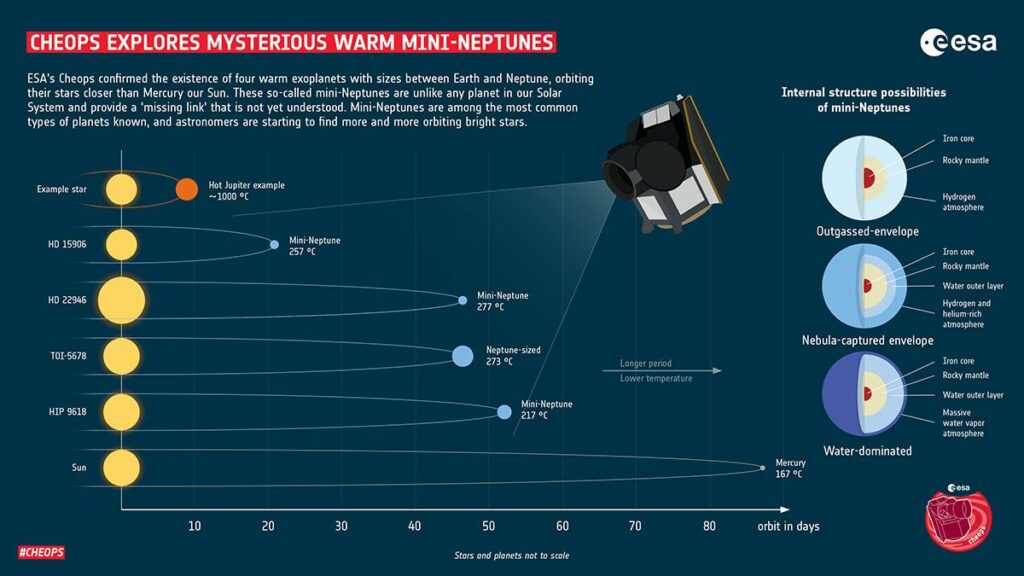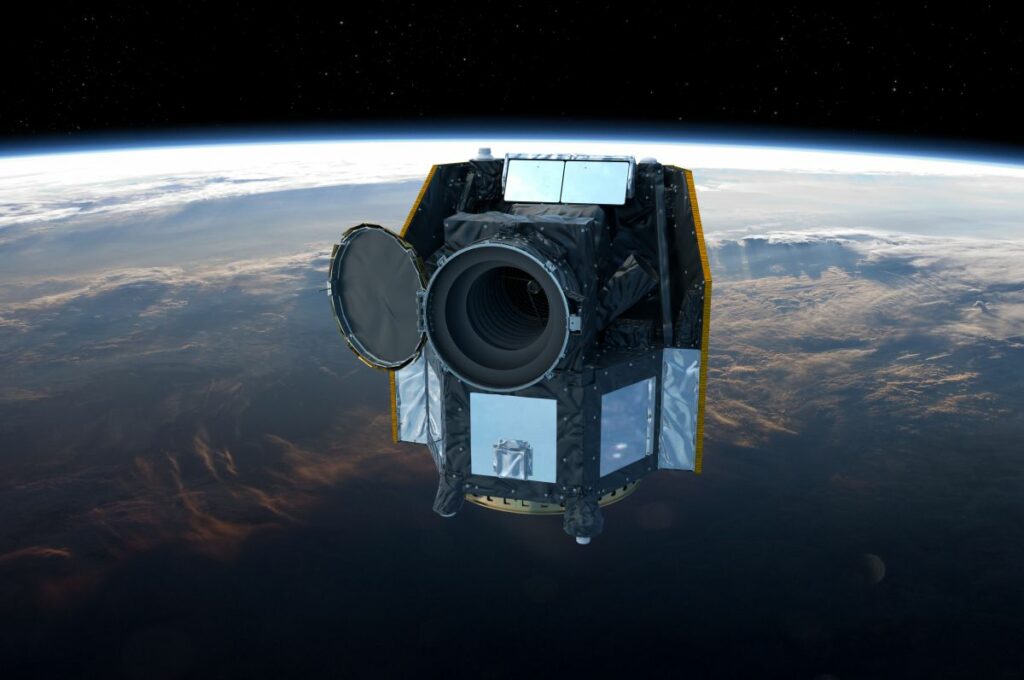Intriguing Cosmic Pursuit: Four Mini-Neptune Exoplanets Discovered Playing Hide-and-Seek
Astronomers have engaged in a cosmic game of hide-and-seek to uncover four newly discovered “mini-Neptunes” orbiting a distant star. These exoplanets, belonging to a category known as mini-Neptunes, are smaller and situated farther from their host stars compared to the more easily detectable hot Jupiters, which are massive gas giants with close orbits.
Mini-Neptunes pose a greater challenge for detection due to their size and distance from their stars. The recently identified planets, approximately the size of Neptune or slightly smaller (about two to five times the size of Earth), orbit various stars. Two of them are in orbit around an orange dwarf star named HD 15906, located 149 light-years away from our solar system.
The research team, led by scientists from the University of Bern and the University of Geneva in Switzerland, employed the Characterising Exoplanet Satellite (CHEOPS), a space telescope developed by the European Space Agency, for the detection of these mini-Neptunes. Prior to CHEOPS’ observations, NASA’s Transiting Exoplanet Survey Satellite (TESS) initially alerted researchers to the presence of these exoplanets. Both satellites utilize the transit method, which involves detecting the periodic dimming of starlight as exoplanets pass in front of their host stars.
“NASA’s TESS satellite excels at detecting the transits of exoplanets, even for the most challenging small planets,” commented Hugh Osborn, an astrophysicist from the University of Bern involved in the study. “However, it changes its field of view every 27 days in order to scan rapidly most of the sky, which prevents it from finding planets on longer orbital periods.”
While TESS observed single transits of two of the exoplanets, TOI 5678 b and HIP 9618 c (approximately 4.9 and 3.4 times the size of Earth, respectively), additional data were required to confirm their existence.

“This is where CHEOPS comes into action: By concentrating on individual stars, CHEOPS serves as a follow-up mission, perfectly suited to continue the observation of these stars and gather the missing pieces of information,” stated Solène Ulmer-Moll, an astronomer from the University of Bern and the University of Geneva involved in the study.
In order to confirm the existence of these exoplanets, scientists utilizing CHEOPS employed a targeted strategy based on the hints provided by TESS to identify additional transits. This approach allowed them to avoid extensive observation time focused on each individual planetary system.
“We then engage in a kind of ‘hide and seek’ game with the planets, employing the CHEOPS satellite,” explained Osborn. “We direct CHEOPS toward a specific target at a particular time, and based on whether we observe a transit or not, we can eliminate certain possibilities and try again at different times until we arrive at a unique solution for the orbital period.”

After conducting several attempts using specialized software that proposes and prioritizes potential orbital periods for each planet, the team successfully confirmed the existence of the two exoplanets. They determined that TOI 5678 b completes an orbit around its star every 48 Earth days, while HIP 9618 c, located approximately 230 light-years away from our solar system, has an orbital period of approximately 53 Earth days.
Using the same methodology, the astronomers also detected two additional mini-Neptunes, HD 15906 b and c, within another planetary system. HD 15906 b has a diameter roughly 2.3 times that of Earth and completes an orbit around its orange dwarf star every 11 Earth days. On the other hand, HD 15906 c, with a diameter just under three times that of Earth, appears to orbit the same star at a greater distance, taking approximately 22 Earth days to complete one revolution.
To obtain a rough estimation of the planets’ masses, the astronomers utilized ground-based telescopes to observe the slight wobbling effect caused by these worlds on the motion of their parent stars. From these observations, they derived the densities of the exoplanets. However, this data alone was insufficient to determine the precise compositions of the mini-Neptunes.
“Although density provides some insights, it is not sufficient for mini-Neptunes, and there are still several hypotheses regarding the composition of these planets. They could potentially be rocky planets with significant gas content or water-rich planets with a highly humid atmosphere,” explained Ulmer-Moll. “Given that the four newly discovered exoplanets orbit bright stars, they become prime targets for the upcoming James Webb Space Telescope (JWST) mission, which may help unravel the mystery surrounding their composition.”
The mini-Neptunes’ location farther from their parent stars compared to typical hot Jupiters, along with their relatively cooler temperatures, suggests the possibility of having atmospheres and clouds that could be explored by the JWST. Moreover, their smaller sizes and longer orbital periods make them intriguing candidates for studying Earth-sized planets orbiting other stars.
The team’s research is published in four separate papers in the journals Astronomy & Astrophysics and Monthly Notices of the Royal Astronomical Society.
Do not forget to share your opinion with us to provide you with the best posts !




0 Comments